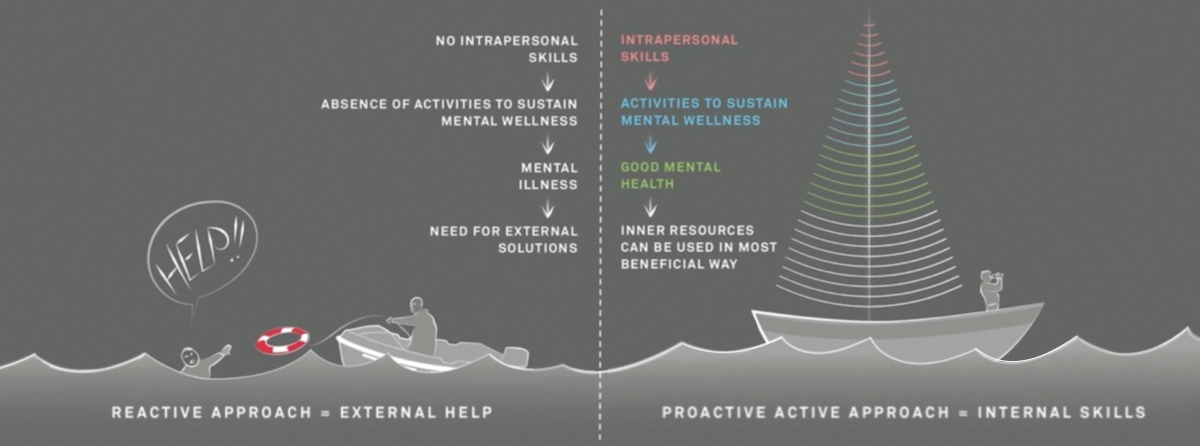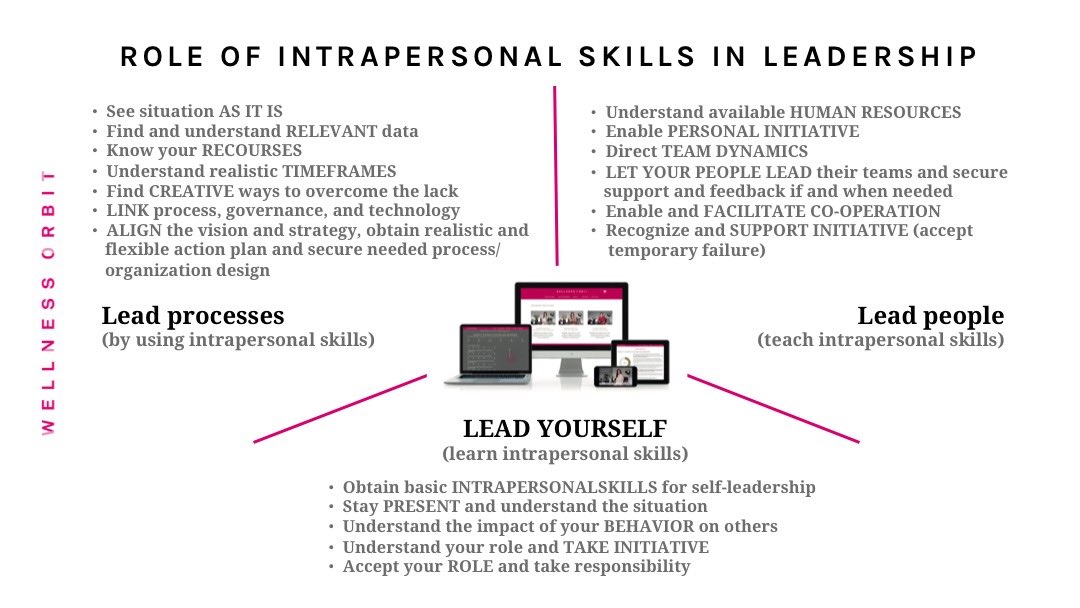Enhancing leader and employee mental wellness is crucial for organizational success
Only leaders who have excellent self-leadership inspire others to thrive. Fostering the mental wellness of both leaders and employees proactively is of utmost importance, especially in today's challenging times.
Regrettably, senior leaders and entrepreneurs often overlook the well-being of mid-level leaders and HR professionals, expecting them to create a positive employee experience on their own. Without systematic intrapersonal education, such a task is hard or impossible as junior leaders have plenty of tasks and responsibilities piling up.
Employee mental wellness initiative demands intrapersonal skills, energy and effort
Senior leaders too frequently forget that employees in their workplace have limits to their capacity. One such limit is time, the other and even more important is a lack of effective skills, especially awareness-based intrapersonal skills.
You just can't fix something you don't comprehend. When you lack a proper understanding of your own intrapersonal processes, you can't secure the mental wellness of others.
The fact remains, none of us have had intrapersonal education or mental wellness lessons in schools.
Prevention and proactivity just don't happen without systematic effort in the case of mental health.
We all have mental health, but it takes time and research to develop an approach that secures mental wellness for people in your organization. Securing leader-wellbeing is what allows to secure employee mental wellness.
Securing the wellness side of the mental health equation is often vaguely understudied. All illnesses are already a result of a lack of wellness. So, it is constant reactivity and rescue vs. leading proactively and paving a path to something new (see the graph below).

Although many leaders acknowledge mental wellness as something significant, they frequently fail to secure excellent mental wellness, employee engagement and productivity in real-life situations.
Securing mental wellness isn't something that junior leaders and managers can figure out on their own, without training their minds first.
The flawed approaches to decision-making are evident as Forbes reported in February 2021 that around 60% of leaders feel emotionally drained by the end of the workday. Also, only 23% of employees are actively engaged (see the Gallup employee engagement levels graph below from this year). So, as a result, most of the people in workplaces wither. However as the graph below shows, it can be different. The potential is there, but it needs to start with stress reduction.

Mental health risks of leaders
Leaders are often more open to stress, burnout and mental health issues than employees. It means leaders need to take time to study how to keep their minds fit and well. This will allow them to move away from a constant inner reactivity-centric decision-making model.
Reactivity always creates emotional and mental struggles, thus it kills proactivity and initiative and spoils interpersonal relations. However, while the mental health risks of leaders are higher than the risks of employees, both need addressing.
Ignoring the potential risks of chronic stress and strain under which many leaders or managers operate doesn't alter the reality.
Reducing chronic stress levels is possible but demands learning coping mechanisms. And sooner is here better than later.
CEOs and directors and HR leaders must be genuinely concerned about the possibility of employees spending more time in negative emotional states, facing anxiousness, stress and burnout problems.
Languishing, a state of diminished mental health, can gradually erode individual and organizational well-being.
Any manager or employee who finds themselves spending most of their day in a constant battle, feeling frustrated, engaged in conflicts or engaging in numerous debates is at risk of burning out and ending up with depression.
Stressed, burned out and depressed managers and employees lose self-leadership and become bitter and often toxic and tend to spread toxic work culture without noticing it themselves. However, learning intrapersonal skills allows one to overcome the toxic workplace problem.
Leadership effectiveness and employee engagement are both directly correlated to mental wellness and stress levels. As languishing and stress increase, leadership effectiveness and employee engagement decrease. Thus procrastination becomes standard.
While some languishing leaders or employees may temporarily appear to be performing well, sustaining this intense stage of burnout is unsustainable. Without intrapersonal skills, personal sustainability is completely impossible.
This is why, knowing how to deal with stress and pressure is here the key to improving work culture.
When a person finishes their workday feeling stressed and thus sees no hope for improvement, they are at risk of facing burnout and/or serious mental health issues.
Experiencing prolonged periods of stress and anxiety can make them short-tempered and lead to a desire to give up. They may start seeking new roles or look for ways to avoid the negativity present at work procrastinate or become passively aggressive. As a result, they are more likely to doubt their competence, become judgmental and exhibit impatience or anger with their teams.
No person thrives when people who own power over them become toxic or frustrated.
A bad work culture kills creativity and personal initiative. Killing those two brings stagnation and replaces innovation with recombing the same old stuff over and over again until your customers no longer see no need for your goods or services.
The solution is securing mental wellness for all
Many organizations invest in training programs to enhance top-level interpersonal leadership skills or employee emotional motivation but up to now too few actually secure access to trainings that support mental wellness proactively. Training your mind comes down to learning practical intrapersonal skills and applying those to solve all your daily situations.
The benefits of self-leadership and intrapersonal skills are explained in the following graph. Take a moment to study it.

It is crucial to notice that leaders or managers can't achieve their maximum potential in leading others if they are incapable of leading themselves first. Regrettably, this aspect is frequently overlooked in many organizations, which will eventually bear the costs associated with neglecting mental wellness. Such soaring costs often lead to the resignation of key personnel regardless of their position or rank.
Workplaces have the opportunity to provide training and support to enhance the mental fitness and mental sharpness of everyone in their team from top to bottom. If it is first done by leaders themselves, and especially when those leaders personally experience the benefits, can they become advocates for improving the mental wellness of the whole team.
When applied systematic workplace-wide proactive mind health training will in turn lead to improved employee engagement, productivity and innovation. Our customers have often given us such positive feedback as they have experienced a positive shift.
Establishing space to gain clarity on self-leadership and setting clear expectations and facilitating the necessary support/recourses to fulfill those expectations allows success.
A systematic approach towards mental wellness and understanding stress and low-engagement level overlap are here crucial to operational decisions that can and work ethics that a difference.
It is essential to evaluate progress on an individual level, and this is something that we have built into all Wellness Orbit online trainings. Using mental wellness trainings here is designed to enhance people's self-awareness and intrapersonal skills. It is excellent self-leadership and mental wellness that allows us to get things done sustainably and creatively.
By prioritizing mental wellness, organizations can foster a healthier and more productive work environment for leaders and employees alike. Such businesses can thrive and amply provide goods and services that make life on this planet better.
Conclusion
Prioritizing the mental wellness of leaders and employees is not only just essential but equally critical for the overall success of an organization. Leaders must recognize that self-leadership based on intrapersonal skills is what represents the specific key to success.
By investing in mental wellness training organizations can promote emotional well-being and mitigate the risk of languishing. Additionally, providing clarity on expectations and ensuring the necessary support for success is crucial in enabling people to steer themselves and others effectively amid challenges.
Remember, the mental wellness of leaders and employees isn't an option but an absolute necessity for sustainable success and developing a healthy and sustainable organizational culture.
This blog post is written by Kaur Lass



.jpg)

